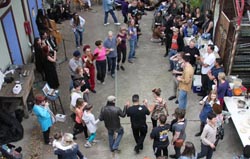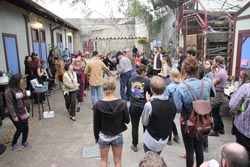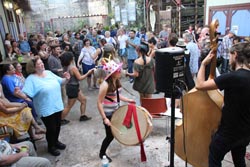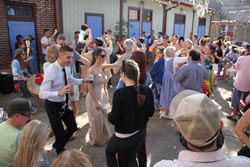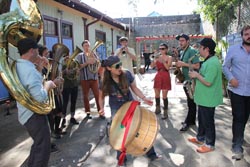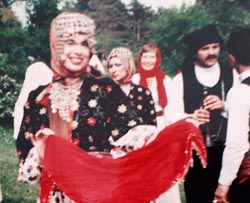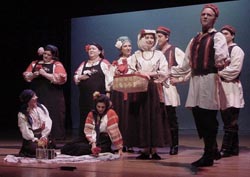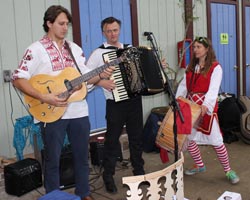The History of the Balkan Fais Do Do
(Or, How I was a Witness to the Birth of the Big Easy Balkan Music Movement)
By Katheryn Krotzer Laborde
Within the walls of a converted New Orleans firehouse courtyard, the air is warm, and the sky is blue save for a blinding splash of sun. People are starting to arrive. A woman places a platter of stuffed grape leaves on the table, and another lugs a large thermos water jug into place. A tower or two of cups are nearby, not to mention a Sharpie to mark the cups with names.
Dancers arrive, some bring food. Musicians arrive, and some fill plates; they won't have time to eat once the music starts. People mingle: some hug a warm hello, some kiss a cheek in greeting. Just as in the days of community dances, the growing crowd is a mix of younger and older and those smack-dab in between. There's inked flesh, and pierced flesh, and flesh that's been around for a while.
Reed-slim and tree-tall, band leader and clarinetist Ben Schenck stands out in any crowd, but all eyes fall on him at this moment as dancers and musicians anticipate the first blasts of horns. Panorama Brass Band members stand along the wall: an alto saxophone, two trumpets, a truba (a rotary valve fleugelhorn). A trombone. Three tenor horns (rotary valve euphoniums), a sousaphone (a marching tuba typical in brass bands). A snare drum and a bass drum.
Schenck gives the signal.
The type of music being played this afternoon in the Big Easy is something known as Balkan brass, a kind of music that traces its roots to the military bands of the Ottoman Empire. It is the sort of music one hears, in the Balkans, at weddings, funerals, and parties. At such events, as many as thirty musicians will play, depending on how much the client is willing to pay (Rault-D'Inca 2012).
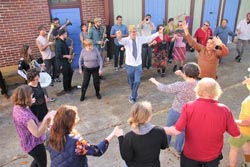
Panorama rips into "Nikolič Čoček," and the dancers smile their approval. They link hands and move their feet in a pattern of steps, transforming the courtyard into a quick-moving sea of bright shirts and skirts and shorts. A good 20 minutes into the set, Schenck puts his clarinet down to join the line, straw fedora tipped over one eye.
Welcome to the Balkan Fais Do Do, the (sometimes) Sunday dance party that takes place in the New Orleans Marigny neighborhood when it doesn't rain and, as percussionist and event organizer Boyanna Trayanova says, "when Michelle says it's OK" (Interview, April 8, 2018).
Oro, Hora, Kolo
There are dogs and children at the Balkan Fais Do Do—the dancers snake around them. There are people who choose to stand or sit, and watch, or chat, or listen. The dancers glide right past them, joined together in a chain that will form and break apart and re-form, over and over, feet following patterns that alternate between groove and flight and the occasional half-second hiccup.
While Balkan time signatures are famously complex, many Balkan dances will have two to four beats to a measure, like much Western music. It is true, though, that many dances (and the songs that inspire them) have five, seven, nine, 11, 12, or more beats per measure. The unevenness of the Balkan step pattern simply reflects an unevenness common to the music itself—a quality that its fans insist is at least partially responsible for its irresistibility.
Longtime folk dancers will pause when a song starts up, gently bobbing their heads to the beat. One will look to the other: "It's a čoček," the one at the beginning of the line might say, taking the hand to the left and starting the pattern that is the dance.
Slow (right) Slow (left) Slow (r) Quick (l) Quick (r) Slow (l) Quick (r) Quick (l)
Seasoned dancers will often break off from the line to join it again in another spot; this is done to help newcomers. Someone who has danced these kolos (Serbian line dances), oros (Macedonian), horos (Bulgarian), and čočeks (Romani) for years can dance in such a way that helps guide the person next in line. Others help by calling out steps.
One does not have to know the dance to join the line, and one does not have to understand the complexities of Balkan music to enjoy it. David Byrne of The Talking Heads was immersed in the music at the Zlatne Uste (Golden Lips) Golden Festival, an annual Balkan music event in Brooklyn, but seemed a little perplexed by time signatures that "are really hard to count, so the dance steps, though not physically difficult, are in patterns that I, for one, could not follow" (Byrn 2018). In truth, the complexities of the rhythms come in three dimensions.
For one, there is meter to consider. "This is the mathematical measure of a repeating unit of rhythm," says Jerry Kisslinger of New York, a veteran Balkan drummer and teacher who performs regularly at Golden Fest (Personal correspondence, May 24-27, 2018). Kisslinger says: "Balkan dance music comes in many meters, often thought of in terms of 2s and 3s [2 = quick, 3 = slow], and with many unusual time signatures from an American perspective. Common ones include 5 (2-3: Pajduško), 7 (2-2-3, Râčenica or 3-2-2, Lesnoto), 9 (2-2-2-3 is most common, Devetorka or Dajčovo). Oddball times of nerdy fascination include 15 (Bučimiš), 18, and 25 (Sandansko). This is one kind of complexity."
The next element to consider is rhythm, or phrase. "This is the actual phrasal expression in time," Kisslinger says.
It is most relevant in the case of the "hesitation" so often found in Macedonian dances like Lesnoto and Beranče, where in traditional versions the rhythm is not metrical, but rather "stretched" (from the point of view of meter). The "downbeat or a beat in the middle comes later than you might expect, by a shade or two, depending on a consensus between lead, drum, and dancer. Kisslinger says:
The radical form of this is something like Teškoto in which the drummer does not play the beat until the dancer steps and the dancer doesn't step until he feels the beat. It's a dialog around phrasing, and they have to know each other and share a sense of the phrase. This is the most interesting element and it fades as the music becomes faster (in an individual dance traditionally and in historical terms) and less local. This is the living time sense, the language of the rhythm. Meter is like an imprecise formalized grammar.
Finally there is pulse, a term that Kisslinger uses "in a way different from musicologists, I understand, to describe the essential accents needed for the dance to feel right. These beats will be present most of the time in a rhythmically good performance, but not necessary in every measure, and are reflected as well in the accenting in the melody."
An appreciation of these complexities is certainly nurtured in one who listens to the music, but not necessarily a complete understanding of them. Michelle Benoit says that "sometimes one of the musicians will call out to me, 'Hey, Michelle, this is in 7'" (Personal correspondence, April 3, 2018). She will nod an acknowledgment but stay in place and wait, listening with both ears and body, before leading the line in Čuperlika.
Patron of the Balkan Arts
Writer, producer, and folk dance aficionado, Benoit is often at the head of a dance line; after all, she attends weeklong "Balkan Camp" dance workshops sponsored by the East European Folklife Center, and danced regularly for years with local folk dance groups. It is Benoit (along with her husband, writer and film maker Glen Pitre) who owns the Firehouse.
As someone who moved to New Orleans already knowing how to jitterbug and chank-a-chank1, Benoit was no stranger to dance. But it was in 1986, during a trip to Nova Scotia with her mother, that she was pulled out of the crowd and onto the stage during a Scottish performance to help fill in for missing dancers; afterward, she was given the name and number of Pat Jessee, leader of the Friends of International Folk Dance Group (FIFDG) in New Orleans.
Throughout the nineties, Benoit used her leadership skills to benefit what was by then called the Crescent City International Dancers (CCID). As such, she would help organize and publicize dance workshops that featured well-known folk dance teachers; Benoit and Pitre played host to many a teacher (and musician) in their large Lockport, Louisiana home.
Helping the Balkan Bands
After Hurricane Katrina, the pair moved to New Orleans and, in addition to writing, film making, and creating the occasional museum installation, Benoit found herself promoting the fledgling Balkan bands that seemed to be suddenly sprouting.
The genesis of the Balkan Fais Do Do is wrapped in pretty paper and served with frosted cake; the event started as a one-time gig at the Firehouse scheduled because Trayanova, with band Mahala ("neighborhood"), wanted to perform on her birthday. Benoit remembers that on that day, Panorama Brass Band saxophonist Aurora Nealand, "on her bicycle and either coming or going, said, 'Michelle and Glen need to host a regular Balkan event here.' And it sprung into being. We informally called it a Balkan Fais Do Do as we started thinking about the when-and-what. I don't remember who came up with that [name], but I do remember Matt Schreiber saying, 'As long as we're appropriating other cultures, what the heck,' so the name stuck.
While it is possible that the Cajun French term was chosen in tribute to Benoit's and Pitre's strong Cajun roots, it is interesting that it is used when one considers the bigger picture. A fais do do is a Cajun dance party, the type of event made popular in New Orleans by the likes of Bruce Daigrepont who has performed in a weekly fais do do since the mid-eighties, extending the popularity of Cajun music and dance in a city that didn't see much of it before the 1984 World's Fair (Willging 2014). While it may be a surprise to some that New Orleans is not Cajun, it's true: Cajuns did not move to the New Orleans area (particularly to the West Bank) until after World War II (Donlon 2004).
Traditionally, a fais do do is family-friendly—another reason why the term fits this Balkan flavored dance party. "Boyanna was clear about wanting it to be held at a daytime hour so as to be accessible to families, and to have food so that it would have a real kefi spirit," Benoit said.2 At the time, there weren't a lot of places booking Balkan bands. There were the occasional exceptions though, like Café Istanbul, and the AllWays Lounge, and the Mudlark—all Marigny music clubs.
The city streets proved to be another exception. One day, Benoit was surprised to hear the "G-String Orchestra playing čočeks and kolos on the streets of the French Quarter. I abandoned my sister in a clothing shop when I first heard them on Royal Street. I said, 'Who are you and why are you playing this music?'" From that point on, Benoit was a friend.
She showed her support for other bands, as well: "Lou Carrig and Jenavieve Cooke Kachmarik started NOLA BalkaNots. Any time they played, I'd make fliers for them, just to help get the word out. If a Bulgarian band was coming through, we made sure folks knew when and where the gigs would be and how to schedule workshops."
The Making of a Scene
A good indicator that a "scene" is a scene and not just a random smattering of performances is the evidence of movement, of change-change of band name, change of band existence, change of band members. In the past few years, this kind of change has been evident. Mahala has disbanded, as has NOLA BalkaNots (formerly known as Balkanika) and the women's choral trio, Pyeya. New bands, such as Balkanique, played on Esplanade Avenue. In 2016, Café Istanbul hosted a Balkan Party that featured three local bands, and Siberia Lounge started its weekly Eastern Bloc Party in fall of 2017.
Siberia advertises that it features "some our city's best musicians performing Balkan, Klezmer and Roma."3 And indeed it does—in addition to Panorama Brass and Backyard Balkan Brass Band, other local bands include Blato Zlato (Bulgarian and Balkan); Csiga Biga (Transylvanian); the Salt Wives (Klezmer); Pasatiempo (Greek); Hot Blood Orkestar (Balkan fusion); G-String Orchestra (Klezmer, Roma, Eastern European); Fyalke (Romanian and Klezmer); and the all-women Balkan folk choir, Trendafilka. The growing scene is exciting to Benoit and others who never dreamed that such was possible in a city not associated with Balkan or Eastern European culture. "Ben Schenk had been cultivating [local] musicians for years," Benoit said, "who would then leave to go play in the New York/Brooklyn Balkan scene." One might say that now the opposite is true: the musicians who are part of the local Balkan scene are all from elsewhere, with the exception of Trayanova, who graduated from Ben Franklin High School in New Orleans but was born in Bulgaria.
The band Blato Zlato (Bulgarian for "Swamp Gold") has been gaining a good bit of attention for its distinctive sound and stellar musicians: Trayanova (tapan), Ian Cook (violin), and vocalists Annalisa Kelly, Ruby Ross, and Lou Carrig (who also plays accordion). The band performs at several clubs around town, and has appeared at the New Orleans Museum of Art. Last year, they recorded their debut music video, "Miatalo Lenche Iabalka" ("Lenche Tossed an Apple"), produced by the New Orleans Video Access Center and funded by the New Orleans Jazz & Heritage Foundation.
The band is more than a local favorite. In 2017, Blato Zlato performed at Golden Fest. In 2018, they played at the popular French Quarter Fest, and spent a good bit of the summer touring Ireland, England, and Bulgaria. Its growing popularity, as well as that of other local bands, indicates that, as Benoit says, "a huge change" has taken place: New Orleans, a town famous for jazz and second lines, now has a Balkan music scene to call its own.
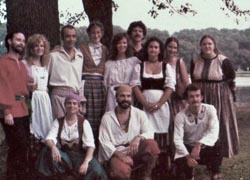
For some, this is where the story would end, with Balkan brass finding a home in the Marigny, longtime folk dancers and newish-to-the-city free spirits joining hands to dance. But I can't help but see this not as one story, but as a complicated braid of a few. A story that goes back to 1968 and involves the International Folk Dance movement, which in turn involves local folk dance groups and a folk performance ensemble. It considers a man who came to this city to study the clarinet and ended up laying the groundwork for a musical movement of sorts, and a woman who, as a child, came to this country to find freedom and now celebrates her heritage with Americans who had already appreciated her country's music and dance long before they met her.
As I told Trayanova one chilly and wet afternoon, we've been waiting for her.
The Balkan Folk Dance "Phenomenon"
At the Balkan Fais Do Do, the break is finished and Backyard Balkan Brass Band takes over. Three trumpets, two saxes, three midhorns (also called euphonium, or baritone horn), a tuba, and a tapan: the band is a collective and Trayanova shares leadership responsibilities with Susan Sakash, J.R. Hankins, and Jenavieve Cooke Kachmarik. The music flows from an energetic original ("2 Exclusive") to the hypnotic "Merakliiski Čoček." Later in the set, Hankins steps up to the mic to sing a Serbian Roma "Mehandija."
Despite the fact that the music and dances are from the Balkans, Trayanova says, the Balkan Fais Do Do is not really like the gatherings one would find in her native Bulgaria: "It's not an authentic Balkan party, but can you have that? Maybe if the people there were all Bulgarians, but Bulgarians in the United States don't do the folk dancing."
In the middle of the courtyard, a group of folk dancers try to fit a dance they know as Thracian Râčenica to a song; the tempo is too slow for that particular dance to work, so they switch to another.
A Romanian priest, distinctive in his full black cassock, joins the line.
A pair of 20-somethings are doing their own thing on the side, one clutching his heart to indicate his love for the music, and the other swinging a handkerchief as he sways, a plastic cup clenched between his teeth.
In the corner, four men of different ages face each other in a loose square. Backs straight, each man raises his arms high as he dances. Each man smiles as he pivots, steps, bounces.
The flavor is Eastern; still, "This is a very New Orleans party," Trayanova says.
While some might see the interest in Balkan music as new to New Orleans, it more or less dates back to the late 1960s, though interest across the United States goes back a few decades earlier. Ethnochoreologist Daniela Ivanova-Nyberg links the Balkan folk dance "phenomenon" to the interest in International Folk Dance (IFD) that dates back, at least unofficially, to the 1930s; the movement drew interest and strength from folk dance demonstrations at two World's Fairs (2011:40).
An American interest in folk dances from afar makes sense—while some might assume that new émigrés would want to embrace all that was "American," one would have to consider that other Americans, new and otherwise, would take pride in their heritage. IFD groups learn many dances from many countries, giving anyone the opportunity to either delve into his or her heritage or, as many do, "adopt" an ethnicity (Ivanova-Nyberg 2011:41).
Fifty Years of Folk Dance in New Orleans
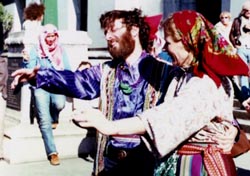
In 1968, folk dance came to town when the New Orleans International Folk Dancers (NOIFD) was formed by Barry Ivker—a Renaissance man of sorts who now lives in Alabama but comes in monthly to dance. Ivker discovered dancing at Indiana University in 1962; when he and wife Fran moved to New Orleans, he found "no folk dance group, and obviously I couldn't survive without it" (Phone interview, May 29, 2018). The group met at the University of New Orleans (UNO) before switching over to a nearby church hall.
Mary Helen Michals, an El Paso librarian who met her husband through the MIT folk dance group in Cambridge back in the early '90s, remembers NOIFD and its enthusiasm: "I was in high school. A friend of mom's mentioned that there was this group folk dancing at UNO, and since I seemed to like ethnic music so much, maybe I might like to try it" (Personal correspondence, May 21, 2018). Soon, Michals and her sister found themselves in the middle of NOIFD. While they had gone with the intention of only watching the dancers, they found themselves doing anything but, and memorably so:
Folks were quite friendly, and kept pulling us into the lines. . . . I was really shy in new situations, and this almost fried my brain. I remember that some nice guys grabbed us and did that polka where they throw the women in the middle of the circle and you have to escape through the ring of men playfully clapping their hands. Freaked. Me. Out. When we finally got free, we got out of there as quickly as was polite.
Before moving to New Orleans in 1975, Pat Jessee had toured Turkey and other countries, learning dances along the way. Back in the United States, she danced with the Baton Rouge IFD group. When she moved to New Orleans, Jessee started a FIFDG and watched it thrive. "I approached the New Orleans Recreation Department about teaching a six-week, once a week folk dance class," she said. The course became a Thursday night tradition: "I ran over a bit by 20 some years!" (Personal correspondence, May 20, 2018).
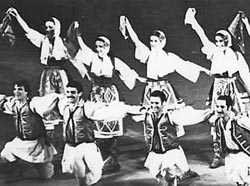
It was Jessee's group that Michals found a couple of years after that first experience. After a trip to the (former) USSR where she was enthralled with demonstrations of spirited Barynyas and joyful Troikas, Michals was ready to try again. "We danced in a big hot gym [that was] kinda catty-corner from Commander's Palace, if I'm remembering correctly," Michals said. "There were huge, huge industrial fans that you could stand in front of, between dances, to cool off your sweat-dripping self—it was so hot. I loved those fans." Soon, Michals was dancing regularly with both groups (as were many if not most of the dancers, some of whom added Elliott Raisen's Israeli group to their schedules). In 1979, folk dancers auditioned for the fledgling Komenka Dance Ensemble. For many, a week consisted of Komenka dance rehearsals, singing rehearsals, and one or two nights of folk dancing.
Jessee moved to West Virginia in the early 1990s, and the board-run CCID was formed when NOIFD and FIFDG merged. Having added "folk" its name, CCIFD now meets on Thursdays at the Starlight Ballroom in Metairie. Once a month, Ivker joins them. On September 8, he and the group celebrated the 50-year anniversary of folk dancing in New Orleans.
But What, Really, is Balkan?
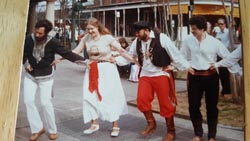
In the "world" of IFD, Balkan line dance became the most popular dance form in the 1960s; there is speculation that this was so because "dancing in a line and holding hands appears to be deeply reflective of the spirit of the time" (Ivanova-Nyberg 2011:43). But while the dances of that region were clearly loved, what was not so clear was exactly which countries were considered Balkan, and the confusion goes beyond the reality of shifting borders and disappearing countries.
That befuddlement about what is considered Balkan is not just the problem of Americans; as Michele Levy noted in a presentation at Xavier University of Louisiana, "even Balkan geography has become a figment of the colonized Balkan mind" (Levy 2018). Referring to an explanation given by a Slovene theorist, Levy explained how even those in the Balkans themselves are not necessarily in agreement as to what is included in that region, mostly because of the negative connotation "Balkan" holds for many (Levy 2018).
Ivanova-Nyberg states that, to American folk dancers, Balkan dances are those from Albania, Bulgaria, Greece, the southern part of Romania, the European part of Turkey and the current countries of Southeast Europe that were once part of the former Yugoslavia (Bosnia and Herzegovina, Croatia, Kosovo, Macedonia, Montenegro, Serbia, and Slovenia) (2011:38). Levy's view is slightly different: the Balkans "usually includes republics of former Yugoslavia, Bulgaria, Greece, Turkey, and Albania. [But] some scholars include Hungary, or Romania, or even Armenia." "Can't see that logic," she adds. "[The] Balkans are named for the Balkan mountains that run through them" (Personal correspondence, May 22, 2018). Talk of Balkan music in New Orleans leads one to wonder about the city's own Balkan population. There is a sizeable Greek population in the New Orleans area; for the past 45 years, attending the annual Greek Fest has been a popular way for hundreds to celebrate Memorial Day weekend along the bank of Bayou St. John.
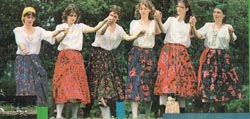
Louisiana's Croatian-American community—residing mostly in New Orleans and nearby Jefferson and Plaquemines parishes—is relatively small. Still, several thousand strong, it counts as the States' largest Balkan population (Ware 2015).
Unless, of course, it doesn't. In her presentation, Levy noted that, at a post-Bosnian War conference on "South-Eastern Europe in The Twentieth Century," Croatia rejected the Balkan label because to be "Balkan" was to be "backwards" (Levy 2018).
Levy was in town with her husband for a conference, but she is no stranger to New Orleans, or to Xavier, for that matter: she was English Department chair for many years before moving to North Carolina in 2002. But her connections to New Orleans are those of a folk dancer. In 1976, three months before her first of three children was born, she joined Ivker's group, having already been initiated into the world of folk dance as a student at University of North Carolina at Chapel Hill.
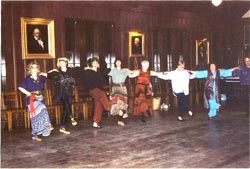
With her long, flowing skirts, it's a joke among the group that to dance next to Levy is to not be able to learn a dance by watching—who can see her feet? But she well represents, both to fellow dancers and anyone who happens to be watching, that which many believe to be the essence of folk dance: the near-spiritual feelings that can flood body and soul when one moves in time to odd rhythms, dancing with many people moving as one, and all of them holding hands.
Music and Dance, Culture and Friendship
A couple of hours after her presentation, Levy's attentions were turned from talking about the Balkans in an academic setting to dancing to its music at the Eastern Bloc Party. It's a reunion of sorts: Benoit picked up Levy at her hotel, and soon the three of us were toasting the gathering with champagne. Later, noshing on what Siberia calls Slavic Soul Food—borscht, pierogi, kielbasa, and the like—we are joined by another folk dance friend, Becka Slifkin. Blato Zlato would be starting at nine, or thereabouts. Ten minutes into the first set we four were sweating and happy. Some in the room watched from a distance; others happily joined in.
The "others" are all younger than we are with one or two exceptions. I'm reminded of why I went to bars and clubs when I was their age—it wasn't to join doyennes in dance. But if there is one thing that seems to be true of the New Orleans Balkan scene, and especially of the Balkan Fais Do Do, it is that it is not ageist.
I am also reminded of how young I was when I discovered folk dancing, albeit through the Komenka door in 1986. At that time, my only prior experience with folk dance had come from gym class.
Komenka, and in turn IFD, changed how I viewed the world. I was exposed to music so different and exciting that I abandoned radio and MTV and instead listened to homemade cassette tapes of music from Hungary, Macedonia, and Bulgaria. I was taught about regional customs and village concerns. I learned to identify, at least vaguely, traditional modes of national dress and headwear: blouses and tunics, aprons and pleated skirts.
It was in Komenka, back in the mid-eighties, that I learned to sing in the full-throttle, gut-blasting Balkan style one hears from Blato Zlato and Trendefilka today. It was in Komenka and IFD, from the mid-eighties on, that I witnessed the long-term bonds formed by people who dance together. It was through IFD that I learned the sweetness of ending an evening singing as the Lesnoto ends, and the circle winds in for a group hug.
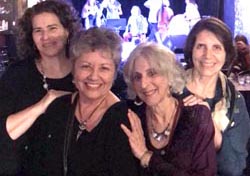
As the women I danced with that night at Siberia would agree—women I've danced with for years—all that has been missing all this time was the regular availability of live music.
Live, Balkan music.
Taking a break, we four grab stools and sit around a tall table: you don't have to dance to enjoy the dark and vibrant cocktail of hardcore harmonies, seductive strings, and tapan.
Trayanova stands with a wide stance, her bent knees helping to support the tapan. A strap holds the rope-wrapped drum low and sideways. The thicker head, made of sheepskin, is pounded by the mallet with her right hand, producing full and low sounds, while the other side (goatskin) creates lighter sounds when hit with a switch. This drum is not the same one she uses when playing with the Backyard Balkan Brass Band——that drum, the one with synthetic heads that she picked up in Macedonia last year, is loud, and its gold metal rim is lined with fleur de lis.
Having lived here since she was 14, Trayanova is a New Orleanian. As is typical to those who lived in the area both before and after the storm, Trayanova marks the events of her life as occurring "before" or "after" Katrina. Unlike most, however, she has first-hand knowledge of what it was like to have lived in a communist country before the fall of the Iron Curtain.
From Sofia to New Orleans, Eventually
Trayanova's grandfather had been a member of the Bâlgarska Komunisticheska Partiy, the Marxist-Leninist Communist group that had been in control since 1946: "He was a serious communist, believed all that stuff, even fought in some early battles," she said (Interview, April 8, 2018). But he was also a respected scientist who studied electricity in muscle tissue. Because of his status of both good communist and good scientist, he was allowed to travel to the United States—a rarity, as even "Serbia was considered 'the West.'"
Trayanova's mother Natalia, also a scientist, landed a research fellowship at Duke University with the help of her (by then) deceased father's connections. Unlike her father, though, she was not allowed to travel; to do so, she had to join the Communist Party, a difficulty for one who objected to the party's beliefs. Trayanova said her mother was warned that she was going to be watched closely when in the States: "They told her, 'We're going to put cameras in the light bulbs' and stuff, which was not true. They spooked her."
In a year, the fellowship ended, and Natalia came home changed. In the United States, nearly everyone drove a car. There had been no food shortages in North Carolina, no standing in breadlines in the freezing cold. Grocery stores were stocked with a variety of foods, some exotic by Bulgarian standards, like kiwi and bananas.
When she returned to Duke the following year, she worked toward having her family join her. "Through the university we were granted paperwork," Trayanova said, "so we had visas and everything. But Bulgaria wouldn't let us out." The university petitioned a U.S. Senator who, in turn, petitioned the Bulgarian government that, in turn, again said no.
Trayanova remembers celebrating her ninth birthday at a party, playing with her friends while her father and "all the parents were glued to the TV, as the Bulgarian dictator was stepping down. [Todor Zhikov] had been in power for about 35 years—my parents' entire life at this point. [His regime] was all they had ever known."
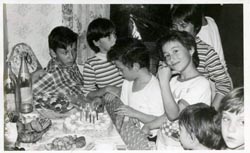
Trayanova's recollection of all that followed is a child's memory, of course. But she recalls a period of "not really chaos or anarchy" but confusion, the kind a country will experience when a people who are used to the government running everything suddenly has no discernable government.
Her father's father was a surgeon and, as such, owned a luxury many Bulgarians of the time did not—a car. In time, "Grandpa drove us across the border. We drove through the former Yugoslavia—[we couldn't] catch a flight there, they [were] in ruins, too. So we went to Italy, me and dad, because that was the nearest place you could catch a flight to the West."
It was January 1990: the beginning of a new year, a new decade, and a new life for the child who did not know any English and was leaving friends, family, and a culture behind.
By the time Trayanova moved from North Carolina to New Orleans, she was already playing drums. Mardi Gras and lively street music convinced her early on that this town was, indeed, right for her. Today, she makes a good living as a drummer, switching from jazz to blues to African to reggae to ska, and is even a celebrity in her native Bulgaria simply because she makes a good living as a New Orleans drummer. Her reputation in her birthland continues to grow because she is "popularizing their unique folk music all over the world." Strangely enough, it's a music she did not play until she joined the Panorama Jazz Band as a snare drum player in 2005.
Planting the Balkan Seed
Trayanova admits that, when it comes to her playing Balkan music, Ben Schenck "planted the seed." Many would suggest that Schenck planted seeds throughout town, playing Balkan music at the Seaport Lounge on Bourbon Street and at the Spotted Cat on Frenchman, before that street had caught on as top place to hear music ("Frenchmen Street was quieter then," Schenck said. "Much quieter."). While many do credit Trayanova for popularizing the Balkan scene in town, others do recognize that, for years, it was Schenck and the Panorama Jazz Band that many associated with bringing what people were then calling "World Music" to the Crescent City.
"Gotta give a shout out to Ben Schenck," Trayanova said, lightly slapping the table for emphasis. "He's kinda the Godfather around here."
Schenck was living in Washington D.C. when the kind of music that would affect his life path seemed to find him: he was introduced to Klezmer through a local radio station that also led him to the music of Macedonia, Serbia, and Martinique. Perhaps most importantly, he discovered the music of Michael White, a New Orleans clarinetist whom Schenck happened upon at a D.C. festival.
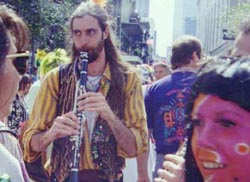
Moving to New Orleans in 1988, Schenck started sitting in with local acts such as Treme Brass Band, Kermit Ruffins, and, naturally, White's band; still a beginner, he didn't "have a lot to contribute, but it was a valuable education. . . . They were very kind to me" (Interview, April 20, 2018). It was his group the New Orleans Klezmer All-Stars that put Schenck's name on the local map. Originally a trio, the band soon found itself playing regularly at a French Quarter coffee house.
Looking back, it is easy to see how Destiny, disguised as the Komenka Ensemble, stepped in one night when the All-Stars played at a local club. "Everyone was doing the butt-shake dance," he said. "Then here comes this group of people, and they start doing a dance that looks like something much more folkloric."
The group was made up of Komenka members. During the break, ensemble directors Daniel Gianfala and John Rodi approached Schenck, asking if his group would perform at the annual spring concert. It was the first of many spring concerts for Schenck who would continue to perform at the event even after he and the All-Stars parted ways.
Schenck learned to play the song "Jovano Jovanke" for one such concert. This marked the first time Schenck played this popular Balkan song, but it was not the first time a good number of the audience had heard it. Members of the folk dance community proved to be Schenck's next connection to what there was of the local (if somewhat underground) Balkan scene.
"Skopski Čoček"
"The first time I heard a Balkan Brass band," Schenck said, "was at a party held by the folk dance group." And the first time he heard a čoček, a syncopated piece of music associated with the Romani people of the Balkans, was one Thursday night at folk dancing. The song was a favorite of the group-a tune the dancers know as "Skopski Čoček." "I convinced somebody to let me borrow the cassette," Schenck said. "I took it home and tried to understand it. . . . It was the ornamentation that was really, really challenging."
Listening to the tape over and over as he did, trying to determine just what it was about the song that made it so exciting, stirred in Schenck something akin to "an erotic crush," a feeling that made him wish he "could play like that." No, more than that. It was a feeling that made him determined to "put a band together that could play like that."
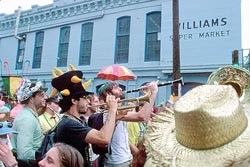
Schenck's Panorama Jazz Band made its debut in November 1995 at a Jewish wedding. In addition to Klezmer songs, they played four or five Bulgarian tunes that Schenck had transcribed from a Soviet-era folk compilation. Like the band that had come before it, Schenck's new group started as a trio: clarinet, sousaphone, and drums. As the months passed, the line-up changed: the tuba player moved away and a new member came in with string bass. The drummer left; the band added banjo, trombone, and accordion. They played one club after another, finally landing a regular gig on Bourbon. "We were kinda hanging out a shingle as World Music at this point," Schenck said.
Two years after the jazz band formed, it was invited to play at a Mardi Gras parade; not really the place for a banjo and accordion. Schenck met the challenge and put together the Panorama Brass Band, albeit by inviting "a couple of other cats to come out and play" and doing a little bit of switching around: the accordionist grabbed the trumpet, the banjoist reached for the bass drum, and the drummer picked up the snare. With a little work Panorama had converted to a marching band.
Or, rather, a brass one that played, at least some, Balkan music.
New Orleans Brass, Balkan Brass
In fall of 1997, I was taking a break from a dance workshop, sitting outside on the steps of the First Presbyterian Church on South Claiborne. I was soon joined by Jerry Kisslinger. I was there to learn some dances; he was in town to play with the band. We nodded our greetings.
Suddenly, there was the sound of a lone trumpet, blasting through the chill of the morning. I was getting ready to say, "Welcome to New Orleans" to the New Yorker, but he spoke first. "This is like being in Bitola," he said.
Bitola, Macedonia,4 was where Kisslinger had spent his first night in the Balkans, where he had experienced the joy that is having "live bands in the restaurants, and a clarinet wailing from the house next door, of music everywhere." The similarities between that place and this were obvious to him. "New Orleans had that," he said. "And the traditions and innovation" (Personal correspondence, 2018).
It was that same trip that he and his wife, Leslie Boden, went to Donna's Bar & Grill, the mecca of New Orleans brass bands until it closed in 2010. Kisslinger was struck by the "overlap on instrumentation" between New Orleans and Balkan brass bands.
And that overlap seems to be most apparent these days in or near the Marigny.
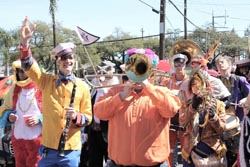
The similarity between Balkan brass and the New Orleans sound is not lost on the brass band players that live and work in New Orleans today. Many of these musicians who came to town in the past several years already had an appreciation of Balkan music, having heard it or played it elsewhere.
Nowadays, they seem to be playing it in or near the Marigny. Michelle Benoit believes that is because clubs such as Siberia, and others, "which are on the fringes of the Marigny, welcome outsider or alternative programming, i.e. music that doesn't depend on tourist dollars but is supported by locals and other musicians."
Meanwhile, part of the reason for the local Balkan boom can be found not only in where in town the musicians choose to live, but that they choose to live in the city, at all. Benoit says:
Many musicians who busk in the Quarter and play in the Marigny and St. Claude Avenue clubs live in the more affordable outskirts of the Marigny/Bywater/Treme/ Upper Ninth (neighborhoods) where those clubs are.
Also, in the last 10 or more years, musicians from the Northeast and the West who know and play Balkan music have moved to New Orleans, where digs are cheaper and gigs with a wide variety of musicians are more available than other parts of the country (Personal correspondence, August 31, 2018).
While that explains why there is Balkan music happening near the Marigny, Schenck sees an overall reason as to why this kind of music is here at all. As he sees it, that reason has roots in political history, the events of which Trayanova experienced firsthand. By the time that the city's current Balkan musicians were moving to town, a good twenty years had passed since "the Iron Curtain came down, so the culture and the music had really begun to filter Westward" (Interview, April 20, 2018).
Finally, well-played and exceptionally rendered music of any stripe will be welcomed because New Orleans is a place "where people insist on actual musicians," Schenck says. "Not just a DJ, not just a synthesizer—they want people to play instruments." Remembering the days just before Katrina, Schenck was always amused when his band "would play a Bulgarian tune at the Seaport, and people would go bananas. They didn't know what it was—they just dug it. I would have people come up to me and say, this is what we came to New Orleans to hear!"
Take the Tapan, Boyanna
Finally, one might say the real reason Balkan music is easier to find in New Orleans these days is because one person met another.
After Hurricane Katrina, some members of the Panorama Brass Band (by then, a separate entity from the Jazz Band) resettled in New York, coming back to New Orleans to march in parades or play at parties. It was at one such party in 2013 that Trayanova was introduced to accordionist Matthew "Max" Fass. Mid-chat, they realized they would both be in Bulgaria that summer.
As planned, Trayanova arrived in her birth country to play at a jazz festival. As promised, Fass contacted her; he wanted to hang out and play. She told him she'd love to but, with the festival providing her drum set, all she had with her were a pair of drumsticks.
No problem.
He introduced her to Maria, the mother of his friend Ivan Velev, who graciously offered to let Trayanova borrow her son's tapan.
Maria lived in a high-rise residential building on the outskirts of Sofia, a building named Mladost—Youth. ("They named the buildings these very, very Communist names," Trayanova said. "Unity! Youth!") Located in these forests of high-rise residential complexes—unattractive and looming, they are architectural reminders of the Communist period—there are random fields here and there between buildings, and it was one of these fields that Trayanova and Fass walked to, accordion and tapan in hand.
They walked past a subway stop on the way to a large field filled with "weeds and tall grasses mostly. And trees," Trayanova said. "There was also a stream nearby and a bridge over it where people gathered to listen to us. No doubt the stream was highly polluted, not an idyllic country setting—this was in the middle of the big city. The place was kind of remote, but also not at all."
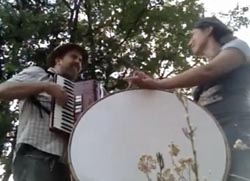
In 2013, Trayanova had never touched a tapan in her life, did not have the mallet and switch to play it, did not even know what each hand should be doing. But that didn't stop her: "We just started playing some Bulgarian tunes. These were rhythms that were in my head from my youth."
When she was a child, living in a Communist country, she didn't hear much Western music. "Bulgarian music was on the radio;" she said. "It was on TV. And as a kid I would think, 'Man, this [music] is old-timey. This is Grandma's music. I don't like this.'" But pounding the drum in the tall grass and smiling broadly, Trayanova discovered that she no longer found the music so old fashioned.
If one is lucky, there comes a moment when all the threads of the life lived thus far come together, fall into place, creating a connection between what was there all along and what is here now. Throughout the video, as Trayanova stops and starts the pounding, as she studies the ring of harsh buildings that surrounds the nondescript field, if from a distance, as she looks at Fass now and again in the way that musicians will, it is clear that Trayanova had come to such a moment.
She filmed the session with her iPhone and posted it on YouTube. Seeing the video, Velev sent Trayanova a message—Take the tapan home to New Orleans.
Trayanova brought the drum back home, wrapped in the Bubble Wrap she always brings with her (there is none, she says, in Bulgaria). What would follow would be meeting one musician and another, creating one band and another, and playing the music of her homeland in a place where people love music in general, and some even know how to dance to this particular kind. That the latter is a reality has been a source of great delight for the woman who came to this country able only to say "I do not understand" and "My name is Boyanna;" who, as a girl, turned her nose up at such "old-timey" music and dancing; who, as a child, grew frustrated when she had to explain that she was not from Bolivia (a country her classmates had heard of) but Bulgaria, a place whose smells and words and customs were locked in her growing bones.
And the rest is, as they say, history. Or at least the history of the Balkan Fais Do Do.
Notes
1. chank-a-chank: Cajun form of jitterbug. The term is also used to refer to Cajun music.
2. Kefi: Greek. Loosely, "joy of life"
3. Siberia website: http://www.siberianolaevent.com/event/315180
4. As of January 2019, this country, which is/was formally the "Republic of Macedonia," is in the process of being renamed "North Macedonia."
Sources
Byrn, David. 2018. Balkanized! Reasons to be Cheerful, February 14. https://www. Reasonstobecheerful.world/article/2018/2/14/balkanized.
Donlon, Jocelyn Hazelwood. 2004. Louisiana's Three Folk Regions. Folklife in Louisiana. Adapted from Louisiana's Traditional Cultures: An Overview by Maida Owens. http://www. louisianafolklife.org/LT/Articles_Essays/la_3_folk_reg.html
Ivanova-Nyberg, Daniela. 2011. A 'Balkan Folk Dance' Phenomenon in the United States: A Few Analytical Observations. Dance Studies, Porte Akademik Journal of Music and Dance Research 2(3):38-45.
Levy, Michele Frucht. "'Under Western Eyes': Colonized Minds in Russian and Balkan Culture and Literature." Presentation given at Xavier University of Louisiana. March 20, 2018.
Rault-D'Inca, Yuna. 2012. Getting Down to Balkan Brass Tacks. Fair Observer. https://www.fairobserver.com/region/europe/getting-down-balkan-brass-tacks/.
Ware, Carolyn. 2015. Louisiana's Croatian American Society: A Case Study in Adaptation and Resilience. Folklife in Louisiana: Louisiana's Living Traditions.
Willging, Dan. 2014. Bruce Daigrepont: A Cajun In New Orleans. Offbeat. http://www.offbeat.com/articles/bruce-daigrepont-a-cajun-new-orleans/


